Old Blue Chip DeFi New Narrative: Application Chains, RWA, LSD, Stablecoins
Author: Grapefruit, ChainCatcher
In the second half of 2023, the successive rise in the prices of tokens such as COMP, MKR, and Aave has brought the long-silent blue-chip DeFi projects back to life.
In the past 30 days, the price of COMP has increased by 150%, currently quoted at $70; tokens like MKR, AAVE, YFI, UNI, and FXS have all risen by over 30%. The price fluctuations naturally attracted attention, leading to discussions about the logic behind their rise and related products.
These once blue-chip projects have been quietly exploring their development paths, with product differentiation becoming increasingly apparent. Some have issued stablecoins, some have pioneered new tracks, some have built their own application chains, and others have transitioned from tool-based products to infrastructure, among other developments.
For instance, the lending giant Maker DAO's endgame plan is to launch a New Chain, Aave is developing both financial and social tracks, and Compound is entering the RWA track; Yearn has opened the first batch of LST asset applications for its LSD product yETH; dYdX has launched a public testnet for its application chain; and Frax has announced its new L2 network, FraxChain, among others.
So, what new developments and narratives do these former blue-chip projects have in their products? Could they be the underlying reasons for the rising token prices?
1. The Lending Giants: MakerDAO Launches Spark Protocol ; Aave Focuses on Stablecoin GHO ; Compound Enters RWA
MakerDAO Launches Lending Product Spark Protocol , Endgame Plan to Build a New Chain
Since the launch of the lending protocol Spark Protocol on May 9, the assets supplied on the platform have exceeded $47.37 million, with $11.92 million borrowed, and the current TVL stands at $35.45 million.
Spark Protocol is the first product developed by Phoenix Labs, organized by core members of the MakerDAO community, aimed at creating new decentralized products to expand the MakerDAO ecosystem. The protocol is a decentralized lending market built on AAVE V3's open-source code, primarily used for over-collateralized lending centered around DAI.
Spark Protocol integrates MakerDAO's DSR (DAI Savings Rate) feature, which is a monetary policy adjustment tool that helps balance the supply and demand of DAI by adjusting the DSR.
For example, when the DSR is raised, DAI holders will withdraw their circulating DAI or exchange other stablecoins for DAI, bringing it back into the Maker system, thus reducing the circulating supply in the market; when the DSR decreases, users will withdraw DAI from the Maker system to seek other yields in the market, increasing the supply of DAI.
Currently, the DSR for users depositing DAI is 3.49%. The collateral assets supported by the Spark Protocol platform include DAI, sDAI (the DSR version of DAI), GNO, WETH, and liquid staking tokens wstETH (the wrapped version of stETH) and rETH.

On July 5, MakerDAO announced that its lending protocol Spark Protocol would expand to multiple chains and released the steps and processes for deploying its protocol across various blockchain networks.
Additionally, according to the original plan, MakerDAO will enter the LSD market through EtherDAI (ETHD) and then guide the use of ETHD through the Spark protocol, supporting ETHD as collateral to borrow DAI, ensuring that the staked ETH tokens are under the control of the MakerDAO application.
From this perspective, MakerDAO has increased the use cases for DAI, deployed a multi-chain market, and entered the LSD track, achieving multiple goals at once.
In fact, these are just part of MakerDAO's endgame plan announced in May, which aims to reshape the MakerDAO brand, deploy a new blockchain network, and transform it from a stablecoin lending product into a Layer 1 infrastructure. By establishing several SubDAOs, MakerDAO will separate its new functions and products, build autonomy, and create new decentralized products based on the Maker system, allowing its ecosystem to flourish. Spark Protocol is the first product of this ecosystem, and more applications based on MakerDAO will emerge in the future, opening a new chapter for MakerDAO's narrative. The roles of MKR and DAI tokens in this ecosystem remain unknown.
In addition to new explorations and plans in product and business development, MakerDAO has also made more attempts in asset yields, becoming the first decentralized financial product to enter the RWA space.
According to official data, as of May, MakerDAO's total investment in the RWA portfolio reached 2.34 billion DAI, primarily used to purchase U.S. Treasury bonds. According to statistics from makerburn, the projected annual income from RWA alone is nearly $71 million, making it an important source of revenue for its protocol.

As users have stated: today's Maker DAO = DeFi + LSDfi + RWA + DAO + Incubator + L2/L1.
However, there are differing opinions on this. Under the proposal of MakerDAO's endgame plan, some users commented that issuing a new chain is not a good idea and may even be somewhat foolish; they should focus more on how to empower the MKR token and how to expand the scale of DAI.

Aave Launches Two Major Products: GHO and Decentralized Social Product Lens Protocol
Entering July, Aave has been increasingly public about its stablecoin GHO. On July 11, the Aave community initiated a proposal vote to launch the decentralized stablecoin GHO on the Ethereum mainnet. If approved, Aave V3 users on Ethereum can mint GHO using their collateral, with the current voting support rate at 100%. The voting deadline is July 14.
GHO is an over-collateralized stablecoin backed by multiple crypto assets. The principle of this stablecoin is similar to DAI, where Aave's aTokens can be used as collateral for minting, with the only difference being that aTokens are interest-bearing assets, allowing users to earn interest income while minting GHO, with the specific rate depending on the supply and demand in the lending market.
Just a day before the proposal was initiated (July 10), Aave founder Stani Kulechov tweeted that the focus for the second half of the year would be on payment use cases in DeFi. He explained that for the DeFi industry in the second half of 2023, attention should be paid to suitable payment use cases, and transparent, decentralized stablecoins are very suitable for payment settlements. This statement was interpreted by users as indicating that the stablecoin GHO will be a key project for Aave in the second half of the year.

In addition to the stablecoin GHO, Stani Kulechov has also been discussing the decentralized social product Lens Protocol, which will release its V2 version during the EthCC (Ethereum Community Conference) in Paris.
Many users speculate whether Lens Protocol V2 will open applications for profile NFTs (which had been paused since April) or announce content related to token governance. Previously, an Aave executive revealed in an interview that the Lens Protocol ecosystem will use the GHO token, for example, in applications within the Lens Protocol ecosystem, users can directly purchase GHO using credit cards to support or tip their favorite creators.
Although it seems that Aave focuses on financial scenarios while Lens Protocol focuses on social fields, the two can be linked through the stablecoin GHO.
Moreover, Aave-like DeFi applications can also integrate with decentralized social applications to develop new social financial products. For instance, the social graph of Lens Protocol could introduce an on-chain reputation system for Aave, developing some collateralized or uncollateralized credit products, lowering the borrowing threshold, meaning users do not need to collateralize any assets and can borrow funds based solely on their on-chain profile NFT reputation and identity system.
Currently, the Lens Protocol ecosystem has integrated or developed hundreds of social applications for users to experience.
Since participating in Lens Protocol ecosystem applications requires a profile NFT, and the current NFT has paused new registrations and is not fully developed for users, along with the stablecoin GHO not yet officially launched, it can be understood that these two major assets of Aave have not yet officially started.
However, from the current product development roadmap, Aave's focus on social products stands out compared to other lending products, but whether it will create the expected positive feedback loop in its ecosystem remains to be seen once the products are launched and operational.
Compound Founder Establishes New Company Superstate to Enter RWA Track
The price of the COMP token has more than doubled in the past 30 days, but compared to the explosive price increase, Compound's product itself seems to have entered a stage of stagnation.
The most recent public information related to the product is that on July 7, Compound Labs launched the Encumber mechanism, which allows users to separate token ownership from transfer rights. By using Encumber, token holders can retain auxiliary ownership benefits such as airdrops, governance rights, or access to content and activities while still participating in DeFi and earning yields.
However, this seems to have little relation to its lending business. For Compound, the only positive news is that its founder has entered the RWA track.
On June 29, Compound founder Robert Leshner announced that he had submitted documents to the U.S. Securities and Exchange Commission to establish a bond fund company called Superstate, dedicated to purchasing short-term U.S. Treasury bonds and putting them on-chain, tracking the ownership shares of the fund through blockchain, and allowing direct trading on-chain. Additionally, Superstate has completed a $4 million seed round of financing, with participation from institutions such as ParaFi Capital, 1kx, Cumberland, and CoinFund.
However, Superstate is still in the application stage.
2. DEX Leader: Uniswap Launches V4 to Transform into Infrastructure; Curve Launches Stablecoin crvUSD
Uniswap V4 Transforms from a Tool Product to a Composable Infrastructure
According to the latest news from the Uniswap Foundation, the Uniswap V4 code is currently under audit, and the specific deployment time will depend on the successful completion of the Ethereum Cancun upgrade and the audit.
In the Uniswap V4 code released in June, the core upgrade introduced an innovative Hooks feature. This feature allows anyone to deploy liquidity pools using custom contracts and attach various functionalities. Previously, Uniswap V3 integrated liquidity pools, meaning liquidity was relatively concentrated for a specific token pair, while Uniswap V4 supports customizable pools for everyone.
Some crypto users have vividly compared this process to eating hot pot: Uniswap V3 is like choosing a big pot for hot pot, where everyone cooks the same flavor without needing to choose, as long as the water is deep enough (liquidity of the fund pool). Uniswap V4 allows everyone to customize their small pots (custom liquidity pools), offering various unique flavors like tomato, mushroom, etc. (analogous to the functionalities added through hooks, such as on-chain limit orders and automatic reinvestment) to attract diners, with a wide variety of tastes for everyone to choose from.
In simple terms, Uniswap V4 will support anyone to do customized development based on it, such as designing matching logic, execution logic, fee customization, rebates and incentives, order range and depth, etc., all of which can be designed through Hooks. Coupled with its newly launched on-chain limit order feature, the dream of building "the Binance on-chain" will become a reality.
This means that developers can build any type of DEX based on Uniswap V4, including contracts, options, and other derivative products, as well as lending protocols, stablecoin protocols, etc. In the future, a vast ecosystem may emerge based on Uniswap.
The Hooks feature increases the composability and scalability of Uniswap's liquidity while also transforming it from a tool-based product to an infrastructure attribute.
Curve Stablecoin crvUSD Locks Over $200 Million in Assets Two Months After Launch
As of July 13, the minted quantity of Curve's native stablecoin crvUSD is 86.02 million, with the value of locked collateral exceeding $123 million.
Currently, the collateral for minting crvUSD mainly consists of sfrxETH, wstETH, WBTC, and ETH. Among these, wstETH accounts for over 60% of all collateral, with a total value of approximately $84.2 million.

Like DAI and GHO, crvUSD is also issued through over-collateralization. However, the difference is that crvUSD introduces soft liquidation. When the price of collateral falls, crvUSD innovatively achieves soft liquidation through a specific AMM and buys back the collateral once the price rebounds.
The issuance of common asset-collateralized stablecoins is equivalent to users over-collateralizing loans, where the collateral assets may be liquidated when their price falls below a certain threshold to repay system debts. However, in such cases, the liquidated collateral assets are priced far below market levels, and even if the collateral asset prices rebound quickly, the position of the collateralizer has already been completely liquidated at a low price, resulting in irreparable losses.
To address this, crvUSD has improved the liquidation process through the LLAMMA (Lending-Liquidating AMM Algorithm) mechanism, achieving soft liquidation by designing a special AMM pool for collateral assets. This allows for gradual liquidation when asset prices fall, rather than a complete liquidation of the position at once. When prices fall to a certain range, the collateral in the AMM will start to be sold for stablecoins, and during the price decline, the collateral will be gradually sold off. When the collateral price drops below the liquidation price, only stablecoins remain in the AMM pool. Once the collateral price rebounds to a certain range, the AMM will help users buy back the assets.
CrvUSD can rebalance the types of collateral based on price fluctuations, thus avoiding users' uncompensated losses and the severe price volatility caused by large-scale liquidations.
However, since crvUSD is still a new stablecoin and has not yet experienced market black swan events that could lead to severe price fluctuations since its launch in May, it remains to be tested whether it can maintain price stability and avoid crashing during market volatility. Additionally, the negative incidents surrounding Curve's founder cashing out and buying luxury homes have cast a shadow over the project's development.
3. dYdX, Frax Launch Application Chains, Yearn Enters LSD
Derivatives Leader dYdX Explores Application Chains
The public testnet for the decentralized derivatives protocol dYdX v4 was officially launched on July 6, allowing users to connect wallets, view order books, place orders, and check account information for testing. This is the final testing step before its mainnet launch.
The main purpose of dYdX V4 is to migrate to the dYdX Chain built on the Cosmos consensus, which will not only enhance its transaction processing speed but also allow the official customization of gas fees. According to previous plans, its mainnet launch is expected to be completed by the end of September this year.
For dYdX users, the most important aspect is that the application chain gives the native token DYDX a new narrative logic.
Currently, the DYDX token can only be used for governance voting, with no other utility, and the application's revenue is not captured by the DYDX token. However, after the dYdX Chain goes live, DYDX will not just be a governance voting token; holders will be able to stake it as network node validators and may also use it as a means of paying for gas fees on the chain. It is reported that the revenue from the dYdX Chain will empower the token.
Currently, the dYdX platform has a 24-hour trading volume of $1 billion and an open interest of $280 million, making it the largest decentralized contract trading platform in the current crypto market.
Algorithmic Stablecoin Frax Enters LSD and Launches New Chain
In mid-June, the L2 network Fraxchain built by Frax Finance officially made its debut, aiming to create a smart contract platform that emphasizes decentralized finance.
Fraxchain is built using Hybrid Rollup technology (also known as mixed Rollup, which combines Optimistic Rollups and ZK Rollups) and is expected to be ready by the end of this year. The network will support all Frax ecosystem assets and will first integrate its official Fraxferry cross-chain bridge for seamless asset transfers.
Additionally, Frax founder Sam Kazemian revealed that Fraxchain will use the stablecoin FRAX and liquid staking tokens frxETH to pay for gas fees on the chain. The fees generated by the Fraxchain network will be partially distributed to FXS holders.
Some users have predicted that the gas fees for Fraxchain are conservatively estimated to be around $1.8 million per year.
From this perspective, Fraxchain is an important battleground for the future value accumulation of Frax Finance.
In addition to launching a new chain, Frax Finance's product frxETH in the LSD track is developing rapidly. As of July 13, approximately 238,000 ETH worth $445 million is locked in frxETH, ranking third in the entire LSD application. Additionally, sfrxETH (staked frxETH) has become one of the top three collateral assets for minting crvUSD; in February this year, the Aave community proposed to introduce sfrxETH as a strategic reserve asset into Aave V3.

Furthermore, in terms of products, Frax Finance has developed and launched the DeFi trifecta: DEX Fraxswap, lending platform FraxLend, and cross-chain bridge Fraxferry.
Overall, Frax Finance has been exploring its business boundaries, developing a complete product line from stablecoins to the DeFi trifecta, LSD, and application chains.
Of course, Frax has not lagged behind in empowering its governance token FXS. On June 30, the Frax community passed a proposal to adjust the repurchase of FXS tokens (FIP-256), intending to use $2 million to repurchase FXS tokens whenever the price falls below $5. Currently, the price of FXS is $6.29.
Related Reading: "How the Established Algorithmic Stablecoin Frax Finance Regained Its 'Status' with the LSD Trend"
Yearn Launches yETH to Enter LSD
On July 5, Yearn announced the latest progress of its LSD product yETH, opening a whitelist application for liquid staking token (LST) projects. yETH is a single LSD token that represents a basket of LST assets, composed of various liquid staking tokens (such as stETH, fxsETH, etc.), which helps diversify investment risks while enhancing investment returns.
In this whitelist application, yETH will ultimately select five LST assets, with the final selection to be decided by a vote from st-yETH holders. This round of applications will close on July 21.
How to participate in the st-yETH voting? Users need to lock their ETH in the Bootstrapper contract for 16 weeks to receive st-yETH at a 1:1 ratio. The five selected LSTs will each pay 1 ETH as an additional reward for st-yETH voting users. Currently, the top five projects are LidoFinance, FraxFinance, StaFi_Protocol, Tranchess, and Swellnetwork.

















